Final report for FNE16-852
Project Information
Every year between May and August potato leaf hoppers (PLH) arrive in the northeast, carried by up from the south. The use of trap crops have been shown to be beneficial in the control of PLH in other crops, and there is a known preference for both alfalfa and clover over hops.This project sought to further understand PLH populations and fine tune the practicality of trap cropping in northeastern hop yards.
When analyses of variance (ANOVA) were conducted on PLH count data, there was no significant difference between the number of potato leafhoppers on sticky cards by alfalfa trap crop treatment. Compaction and tractor traffic make it very difficult to establish a trap crop on the drive row ends of a hop yard. Because the alfalfa did not establish well, we have analyzed the data collected by location relative to the surrounding potato crop for both 2016 and 2017 to further understand the movement of PLH across our landscape.
In this study on our farm, PLH populations were highest on plants closest to the surrounding potato fields regardless of wind speed. PLH is an insect that will move from one host field to another very quickly after any physical or chemical disturbance in a nearby field. The edges of our hop yards that were closest to the surrounding potato fields showed the highest mean number of PLH on hop plants, regardless of wind direction. Furthermore, in our location the youngest plants that also happened to be near the potato field were damaged the most by PLH. Observationally, Cascade was the mature variety with the most PLH damage, even though it was located in the middle of both yards.
Alfalfa trap crops should be larger than 30 ft wide if a potato field or other host crop such as alfalfa, bean, or clover occupies adjacent fields. We would recommend spraying this larger, East/West trap crop about 2 weeks before the PLH peaks in late June. We believe that the trap crop needs to be sprayed because if the population were not killed, they would spill over into the hop yard. However, it is important to keep in mind that the act of spraying or even driving through the trap crop or adjacent crop fields can disturb PLH, triggering them to lift up and fly over to an adjacent crop (hops).
We held a field day in partnership with UVM at the farm to discuss the project and publicize both NESARE and the work we were doing in August 2016 wiht a turnout of 125 farmers, agricultural professionals and researchers. This project was just one of many issues and items addressed at that field day. Current and future hop farmers learned of the information gathered to that point (8/2016) which was presented by Jacob L’Etoile of Four Star Farms. Dr. Lily Calderwood (cooperator) and Eugene L’Etoile (Four Star Farms) presented the results at the Cornell Hops Conference on 12/2/2017.
Introduction:
Four Star Farms is located in Northfield, MA on Hadley silt loam along the Connecticut River in the Pioneer Valley. We are a family farm that has been growing hops for 9 years, in addition to small grains and turf for our local markets. We have three hop yards in close proximity to each other . Hop Yard 1 is our oldest yard, and is roughly 3/4 of an acre. Its layout does not make it conducive for use in this study. Hop yard 2 is 6.5 acres, and is a few years younger (1/2 is 4 years old, 1/2 is 3 years old) and is more properly laid out for this work. Yard 3 is our largest at 10 acres, and youngest yard (most of the plants were planted in the spring of 2015.) It contains many of the same varieties, but will present a very different age class of plants, and is laid out in a manner conducive to this project.
Every year between May and August potato leafhoppers (PLH) arrive to the northeast, carried up from the south on storm fronts. While there has been research into their management on other crops produced in the northeast, until now, none has been conducted on hops in this region in the last half century. Over the last decade there has been a resurgence of hop production in the Northeast, and PLH have become a formidable challenge. There are crop protection tools available for the control of PLH, but they are broad spectrum, harming both pollinators and beneficial predators important to the control of another major pest in hops, spider mites. The use of trap cropping in hops to manage PLH has shown preliminary promise as an IPM tool from University of Vermont research.
Planting a trap crop amongst the hops has tradeoffs: it decreases airflow promoting hop downy mildew; provides a refuge for pests; and removes the ability to use tillage and hilling to control weeds and new hop shoots. This tillage is the only cost effective non chemical form of weed treatment we have.
Work conducted by UVM Extension confirmed that potato leafhopper (Empoascafabae, PLH) is a pest of hops. They measured net photosynthesis on first year hop leaves that were exposed to 3 adult PLH, and leaves not exposed to any PLH at Borderview Farm in Alburgh, VT. In the field, adult PLH reduced photosynthesis of hop leaves by 32.7%. Additionally, UVM studied the impact of cover cropping hop drive rows with red clover and mixed flowering plants on hop insect pests. Their most significant finding was that the red clover treatment acted as a trap crop for PLH. PLH were most abundant in second year red clover that was not mowed. Their preference in that system was first red clover, then hop plants, then the flowering mix. These research projects on PLH as a pest in northeastern hop production was conducted as part of a University of Vermont Ph.D. dissertation (Calderwood 2015) and NESARE graduate student grant (GNE12-033).
PLH has been studied extensively as an economically damaging pest of alfalfa. Certain varieties of alfalfa are more susceptible to PLH feeding compared to others. A study conducted by Straub et al. (2013) showed that PLH preferred to feed on monocultures of alfalfa compared to mixed stands of alfalfa and clover. Anecdotally, growers have noticed that when nearby alfalfa fields are cut for hay PLH migrate from this vegetation to nearby hop yards. This mass migration of PLH causes significant damage to first and second year plants in particular.
Objectives The objective of this project was to allow both organic and conventional hop farmers across the northeast to better understand if and how a legume trap crop could be used to reduce pesticide usage while minimizing the trade-offs from weed and hop downy mildew pressure. We sought to understand if a 30ft wide strip trap crop on the N and S sides of 2 hop yards would be big enough of a draw PLH away from hop plants. We were also interested in further understanding whether we needed to spray the trap crop and how the crops that surround our hop yards influence PLH in the hop yards.
Cooperators
Research
Alfalfa was planted in May 2016 and reseeded in late August 2016 due to establishment difficulty. Alfalfa establishment was delayed due to drought conditions and yard maintenance traffic. In 2016, the neighboring farmer planted a 24 acre potato field on the west side of both hop yards (B and C). In 2017, potato acreage was 80 acres on the south side of the B yard. This provided an additional and much larger trap crop compared to the planted alfalfa for potato leafhopper. This variable was not planned and impacts our alfalfa trap crop results. Due to both drought and potato field factors, it turned out that there was not a strong alfalfa trap crop yet there was the potential for a strong potato trap crop. In both years sticky traps were hung 6-8ft up in hop plants. The number of PLH were counted and recorded weekly. Data collection occurred between June 3rd and August 5, 2016 with 84 sticky traps were hung and collected each week. Because this number of sticky traps was very time consuming, we reduced the number of cards to 18 (9 in each yard) for the 2017 season in addition to reducing the number of collection dates (Table 1). Data collection occurred between June 8th and July 20, 2017. In both years, the sticky traps were placed in each corner and center of the hop yards. Sticky traps were placed in the designated alfalfa plots and collected weekly in 2016, yet not in 2017 due to the uneven presence of alfalfa. Analyses of variance (ANOVA) were conducted using JMP Pro 12.
In the first year, 2016, of this two year project we have monitored PLH in marginally established alfalfa trap crop treatments and on the hop plants. While sampling has already occurred and will be continuing in the second year of the project, the first year has been necessary to try and allow the alfalfa to establish. This first step has proved more challenging than anticipated - with vehicular traffic required over this establishing crop on a very regular basis, it has proven difficult.
Trap crop treatments were planted perpendicular to the hop rows on the north and south ends of our “Old” and “Young” hop yards. Our treatments were replicated 4 times and included: sprayed alfalfa trap crop, nonsprayed alfalfa trap crop, and no trap crop (mowed grass or tilled control). Four, 10ft wide and 220ft long blocks and four 10ft wide and 125ft long blocks of PLH susceptible alfalfa was planted at a thick stand seeding rate in early spring as soon as the ground thawed. Irregular early warmth followed by irregular late cold presented challenges for establishment. The alfalfa trap crop was not be mowed until after hops are harvested each year.
Starting on May 17th the hop yards were scouted weekly by Lily Calderwood & Four Star Staff - not only did they provide assistance but learned valuable scouting methods and protocols at the same time. PLH were scouted using sticky traps and a sweep net through mid August. Due to the planting of a large swath of potatoes directly adjacent to our hops, minimal scouting and agronomic practice tracking was added to make sure we were accounting for a huge PLH attractive crop planted directly next to the hops. The trap crop did not establish sufficiently to do sweep netting in the trap crop.
Hop plants were scouted using 3x5 unbaited yellow sticky cards. Two hop rows were randomly selected per trap crop treatment. Each row had 7 sticky cards placed at different distances from the treatments. One plant was randomly selected at 5ft, 20ft, 50ft from the end of each row. An additional plant was selected at 400ft in the middle of each row for a total of 7 sticky cards per row. One sticky card was placed in the center of each of the 84 total plants. Sticky cards were secured with clothes pinned to a piece of coir. The coir rope was tied to each of two climbing bines at a height of 8 ft in the canopy to hold the sticky card at that height.
We worked with our technical adviser, Lily Calderwood, to gather and review that data in both 2016 and 2017 in an effort to reduce our pesticide use and manage PLH on the farm. Our results indicated that our 30ft wide alfalfa trap crop treatments were not large enough in our working landscape that includes significant acreage of potato. PLH is an insect that will move from one host field to another very quickly after any physical or chemical disturbance in a nearby field. The edges of our hop yards that were closest to the surrounding potato fields showed the highest mean number of PLH on hop plants, regardless of wind direction. Furthermore, in our location the youngest plants that also happened to be near the potato field were damaged the most by PLH. Observationally, Cascade was the mature variety with the most PLH damage, even though it was located in the middle of both yards.
Monitoring the PLH in the trap crop was challenging. We did however still gather incredible amounts of data relative to PLH in the hops, and how they changed versus activity in the neighboring potatoes, and in the hop yard itself.
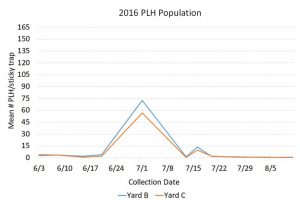
Below are some general observations that we have been able to gather from the first year's data:
No significant difference between the number of PLH when measured compared to the distance from the potatoes in either hop yard.
There was a significantly higher number of PLH in the south B yard for every variety when compared to the same variety in the C yard. PLH arrives from the south so it is not surprising that the southern side showed higher PLH numbers.
The B yard was surrounded by potato fields on 2 sides. The C yard had potato field adjacent to one side. When the potato was sprayed for PLH in June, PLH flew up, out of the potato and onto hop plants in both B and C yards. This resulted in a spike from around 5-10 mean PLH per sticky trap in all other weeks to well over 50 mean PLH per sticky trap the monitoring date following the adjacent spray event.
Preliminary, there was no difference in PLH across varieties.
Final Results
When analyses of variance (ANOVA) were conducted on PLH count data, there was no significant difference between the number of potato leafhoppers on sticky cards by alfalfa trap crop treatment. Because the alfalfa did not establish well, we have analyzed the data collected by location relative to the surrounding potato crop for both 2016 and 2017 to further understand the movement of PLH across our landscape.
In 2016, the PLH population peaked during the week of July 1st with Yard B having a higher mean number of PLH compared to Yard C (Figure 1). There was a second population peak July 16th 2016. Examination of our on-farm weather data for the preceding week showed a low pressure front with 10-15 mph wind gusts from the southwest (area of the potatoes) arrived on July 14th. In 2017, the population peak was right around the same date on June 29th with a significantly higher population in Yard B which was closer to the potato fields.
In 2016, when the surrounding potato field to the northwest was sprayed for potato leafhopper the week of June 24, the physical and chemical disturbance caused PLH in the potato to relocate to adjacent hop yards. Our July 1 collection yielded a staggering number of PLH per sticky trap (150/trap in some locations). Following this mass relocation of PLH from potatoes to hops, the hops were sprayed with Sniper insecticide on July 3, 2016 right on schedule to also manage Japanese beetle. This application also knocked down the PLH population. Looking at the data, July 1st is an outlier. This mass relocation date depicted a phenomenon that had been observed in hop yards adjacent to alfalfa fields, yet not documented in northeastern hops until now. Showing the mean number of PLH by location in the hop yards is now important. Figures 4 and 5 show the mean number of PLH at each sticky trap location in hop yard B, without the July 1st outlier in the data (Figure 2) and with the July 1st outlier in the data (Figure 3).
Overall the total number of PLH was much higher in 2017 compared to 2016 even though the potato fields were further away from the hop yards in 2017.
2016 Date Total PLH Mean/card 2017 Date Total PLH Mean/card
6/03/16 232 2.5
6/08/16 261 2.8 6/08/17 13 0.9
6/15/16 142 1.5 6/15/17 216 12.0
6/20/16 348 3.7 6/22/17 570 31.7
7/01/16 5722 60.9 6/29/17 1508 83.8
7/06/17 434 24.1
7/13/16 100 1.1 7/13/17 49 2.7
7/16/16 942 10.0
7/20/16 138 1.5 7/20/17 34 1.9
7/27/16 115 1.2 7/27/17 4 0.5
8/04/16 51 0.5
8/11/16 67 0.7
Table 1.
Collection dates, total PLH counted on that date, and mean PLH/card for both 2016 and 2017.

Figure 1. Mean number of potato leafhoppers (PLH) in hop yards B and C in 2016 by collection date. The mean number of PLH per sticky trap, regardless of location or hop variety was slightly higher in yard B.
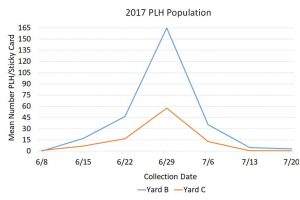
Figure 2. Mean number of potato leafhoppers (PLH) in hop yards B and C in 2017 by collection date. The mean number of PLD per sticky trap, regardless of location or hop variety was significantly higher in yard B (P<0.05).
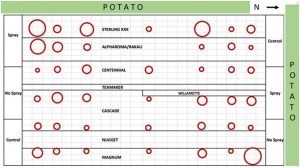
Figure 3. Hop yard B mean overall mean number of PLH/sticky trap at each location excluding July 1, 2016, which was an outlier. The mean number of PLH/trap at any given location is equal to the diameter of the circle in that location. For example, plot 807 had a mean of 7.4 PLH/trap and the circle has a diameter 0.74” in excel.
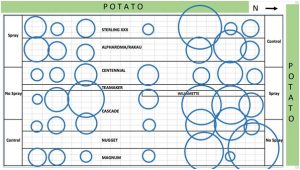
Figure 4. Hop yard B mean overall mean number of PLH/sticky trap at each location including the July 1, 2016 outlier PLH peak date. The mean number of PLH/trap at any given location is equal to the diameter of the circle in that location. For example, plot 807 had a mean of 22.4 PLH/trap and the circle has a diameter of 2.24” in excel.
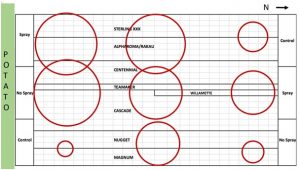
Figure 5. Hop yard B mean overall mean number of PLH/sticky trap at each location excluding the June 29, 2017 outlier PLH peak date. The mean number of PLH/trap at any given location is equal to the diameter of the circle in that location. For example, plot 807 had a mean of 22.4 PLH/trap and the circle has a diameter of 2.24” in excel.
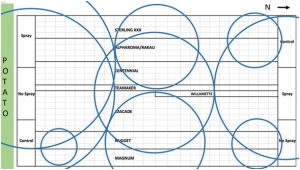
Figure 6. Hop yard B mean overall mean number of PLH/sticky trap at each location including the June 29, 2017 outlier PLH peak date. The mean number of PLH/trap at any given location is equal to the diameter of the circle in that location. For example, plot 807 had a mean of 22.4 PLH/trap and the circle has a diameter of 2.24” in excel.
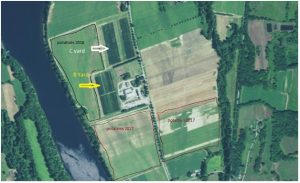
Figure 7. Overhead view of Four Star Farms, showing location of yards and potato plantings in both 2016 and 2017.
In the past, growers in our region have observed higher PLH abundance on the south-side of hop yards. This observation is farm dependent. Each farm has a different microclimate that impacts where the PLH land. If your hop yard is where the PLH first land, then they are likely to be on the south side. However, if PLH arrive to another host plant in your landscape first, and then move over to your hop yard, the PLH are more likely to arrive in the direction of that crop. In this study on our farm, PLH populations were highest on plants closest to the surrounding potato fields regardless of wind speed.
Compaction and tractor traffic make it very difficult to establish a trap crop on the drive row ends of a hop yard. Depending on the hop yard orientation, alfalfa trap crops should be located on the sides of a hop yard that do not get heavy row traffic. We were driving over an establishing drop to string, train, spray, weed, and harvest, never allowing it to establish. This quickly made a North/South trap crop unrealistic on our farm. If the trap crop had been located on the East and West sides of the hop yards, we would have had better establishment.
Alfalfa trap crops should be larger than 30 ft wide if a potato field or other host crop such as alfalfa, bean, or clover occupies adjacent fields. We would recommend spraying this larger, East/West trap crop about 2 weeks before the PLH peaks in late June. We believe that the trap crop needs to be sprayed because if the population were not killed, they would spill over into the hop yard. However, it is important to keep in mind that the act of spraying or even driving through the trap crop or adjacent crop fields can disturb PLH, triggering them to lift up and fly over to an adjacent crop (hops).
Education & Outreach Activities and Participation Summary
Participation Summary:
We held a field day in partnership with UVM at the farm to discuss the project and publicize both NESARE and the work we were doing in August and had a very good turnout of growers and researchers. This project was just one of many issues and items addressed at that field day. Current and future hop farmers learned of the information gathered to that point (8/2016) which was presented by Jacob L'Etoile of Four Star Farms
A presentation was made by Dr. Lily Calderwood (cooperator) and Eugene L'Etoile (Four Star Farms) at the Cornell Hops Conference on 12/2/2017
Learning Outcomes
We have also learned the importance of using sticky traps in our hop yards.
Project Outcomes
We will continue to use a few sticky traps in our hop yards to monitor the PLH population in the hops and on surrounding crop fields.
Because we also grow turf near our hop yards, Japanese beetle is our second economically damaging insect pest in the hops. We already have to spray for Japanese beetle in late June/early July. Therefore, based on when we have observed PLH populations to peak (late June/early July), it makes sense for us to use one application of systemic insecticide that is labeled for both Japanese beetle and PLH 2 weeks prior to the expected PLH peak. We have also learned the importance of using sticky traps in our hop yards. These do help us to monitor the PLH population in the hops and on surrounding crop fields and we will continue to use a few. Further research is needed to understand the use of a legume trap crop on the west side of our hop yards. Additionally, in hopes of further reducing our pesticide use, we would like to know the efficacy of only spraying the outer edge row of the hop yard to manage PLH.